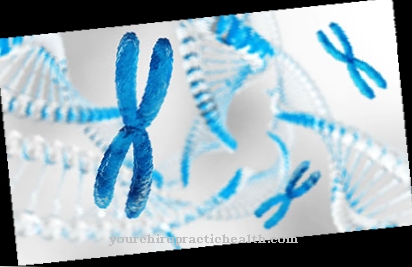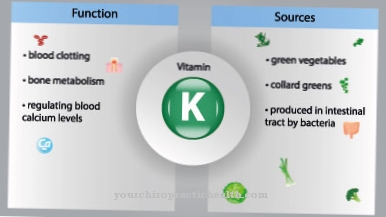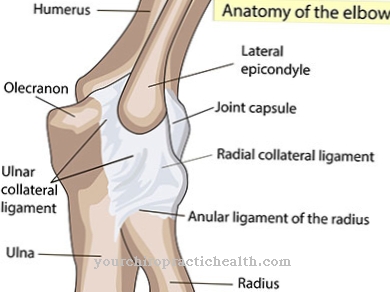As Protein S deficiency is an acquired or congenital blood disorder. The protein S deficiency increases the risk of so-called leg vein thrombosis. In many cases the disease goes unnoticed for years; preventive measures are not known due to the fact that it is a hereditary disease. In fact, preventive measures are not possible; As a rule, only the complaints and symptoms can be alleviated once the disease has been diagnosed.
What is Protein S Deficiency?

© Kateryna_Kon - stock.adobe.com
Of the Protein S deficiency is a congenital disorder of the blood clotting system caused by a lack of protein S, an anticoagulant protein. Protein S deficiency is a fairly rare disease; just 0.7 to 2.3 percent of the population suffer from the form of the disease. Protein S is produced in the liver and, due to the anticoagulant factors, ensures limited clot formation in those places where vascular injuries have occurred.
If there is a deficiency in the protein, however, the blood clot formation predominates, so that the person affected must expect more and more clots to form within his intact blood vessels than a person who does not have a protein S deficiency. This fact increases the risk of leg vein thrombosis.
causes
If the deficiency is based on a genetic defect, the probability that it will be passed on is 50 percent. The protein S deficiency can also result from a so-called vitamin K deficiency, chronic infections, the use of ovulation inhibitors or vitamin K antagonists, and liver diseases.
As a further consequence, inflammations, burns, sepsis or multiple trauma can also be responsible for the development of protein S deficiency. However, acquired protein S deficiency is relatively rare; it is mainly the inherited genetic defect or the so-called spontaneous mutation, if a genetic defect is present but it was not inherited.
Symptoms, ailments & signs
In many cases, patients notice the protein S deficiency between the ages of 15 and 45. Especially women who are not yet aware of their disease often notice problems with the protein S deficiency when a thrombosis - the vascular occlusion - occurs in the deep leg veins.
Risk factors such as hormone preparations for menopausal symptoms or the birth control pill are primarily responsible. Occasionally, pregnancy can also be a reason why doctors find a protein S deficiency. In men, too, a random diagnosis usually follows if a thrombosis has already occurred.
However, if it is known that the protein S deficiency was inherited or there is a possibility of inheritance, initial tests can be carried out as early as adolescent or childhood to determine whether or not there is a protein S deficiency. If there are no symptoms or complaints, the doctors - if there is no genetic defect in the family - will not carry out any such examinations.
As a rule, if there is a possibility of inheritance, examinations are carried out in childhood so that preventive measures can be taken that do not stop or change the course or the disease, but sometimes do not allow any complications at all - with regard to leg vein thrombosis.
Diagnosis & course of disease
The doctor can diagnose the disease on the basis of a blood analysis of the patient. If there is a suspicion that there is an increased tendency to clot, the doctor takes blood and analyzes it within the scope of laboratory technology. As a result, anticoagulant factors in the blood can be analyzed, which sometimes suggest a protein S deficiency.
There are no other options available to the doctor. It should be noted that the diagnosis is often only made by chance. As a rule, patients contact their doctor for other reasons; for example, if a leg vein thrombosis has developed and it is to be treated. Occasionally, the protein S deficiency can be diagnosed - even if only by chance - when the patient is pregnant. As part of various preliminary examinations, it is possible for the doctor to diagnose protein S deficiency.
Complications
In most cases, the protein S deficiency is recognized relatively late. In the worst case, a thrombosis has already occurred, so that urgent treatment is necessary. The protein S deficiency itself is usually passed on genetically, so advice should be given before planning a pregnancy.
Apart from thrombosis of the leg veins, there are usually no special complications. However, these can be treated so that the life expectancy of those affected is usually not influenced by this disease. The treatment of the disease itself is carried out with the help of drugs. There are no complications and the medication usually has no side effects.
Furthermore, those affected are also dependent on wearing special stockings. The thrombosis itself can lead to significant restrictions in the patient's movement. The patient may then be dependent on the help of other people in his everyday life. Unfortunately, it is not possible to prevent protein S deficiency. However, this should be diagnosed at an early stage if the relevant information about the course of the genetic material is known. This can prevent the thrombosis.
When should you go to the doctor?
Since protein S deficiency does not self-cure and in most cases there is a significant reduction in the patient's quality of life, this disease must always be treated by a doctor. An early diagnosis and treatment always have a positive effect on the further course of the disease and can prevent various complications. In the case of this disease, the doctor must be consulted in any case if thrombosis develops. The protein S deficiency can also lead to various complications during pregnancy.
If the patient suffers from the disease and is pregnant, a visit to a doctor is highly recommended. Thromboses can develop, especially in the leg veins, so they should be treated at an early stage.In most cases, the general practitioner can diagnose and treat the protein S deficiency. As this condition is a hereditary condition, genetic counseling can also be carried out to prevent the condition from being passed on to the next generation.
Treatment & Therapy
Since the protein S deficiency is based on an inherited genetic defect, there are sometimes difficulties in treatment, since no treatment of the cause is possible, only alleviation of the symptoms. For this reason, therapies are mainly based on the patient's state of health.
However, patients who have no symptoms and who have not yet suffered a thrombosis will usually not be prescribed permanent medication. However, patients are advised to notify the doctor if risky situations arise so that preventive measures can be taken. Patients may be able to be treated with heparin, an anticoagulant drug.
Support stockings are also an advantage on longer journeys. If the patient knows they have a protein S deficiency, preventive measures are available. In many cases, these are more helpful than those treatment options that are primarily used only to alleviate symptoms. In many cases the protein S deficiency goes unnoticed; there have been no symptoms or complaints for years. For this reason, doctors often only diagnose a protein S deficiency when the first thrombosis has already been detected.
Long-term treatment, for example with so-called vitamin K antagonists, is advisable if several thromboses have already been diagnosed. Incidentally, one of the vitamin K antagonists is Marcumar, probably the best-known preparation when it comes to an anticoagulant effect.
prevention
Since protein S deficiency is a hereditary disease, no preventive measures are known. If a protein S deficiency has been diagnosed, only preventive measures can be taken to positively influence the course of the disease.
Aftercare
In order to minimize the risk of leg vein thrombosis, it makes sense to have the blood values checked regularly by an experienced doctor after successful therapy for protein S deficiency. In this way, new complications with blood clotting can be detected early and treated immediately with medication. As with other thrombotic diseases, a protein S deficiency can easily lead to liver disease. It is advisable to severely restrict alcohol consumption and, at best, avoid it completely.
In vascular medicine, those affected receive useful nutritional recommendations and valuable information on how to proceed in an acute emergency. During pregnancy, the additional physical strain can easily lead to thrombosis. Pregnant women with protein S deficiency should definitely inform their gynecologist about their blood disorder and strictly adhere to the instructions of the treating doctor.
Getting enough exercise and daily walks can help prevent venous thrombosis from developing. Since those affected often have a vitamin K deficiency, doctors often recommend the preventive use of special dietary supplements. Compensation can usually not be guaranteed through food intake alone.
Long-term use of blood coagulation-promoting medication such as low-dose aspirin should always be discussed with the attending physician. The use of hormone preparations that contain estrogens should be avoided if possible. These medicines are often prescribed to prevent pregnancy (“anti-baby pills”) or for menopausal symptoms. Medicines containing estrogen also lower the protein S concentration in the blood.



























